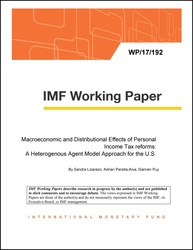
Macroeconomic and Distributional Effects of Personal Income Tax Reforms
A Heterogenous Agent Model Approach for the U.S
This paper assesses the macroeconomic and distributional impact of personal income tax (PIT) reforms in the U.S. drawing on a multi-sector heterogenous agents model in which consumers have non-homothetic preferences and sectors differ in terms of their relative labor and skill intensity. The model is calibrated to key characteristics of the US economy. We find that (i) PIT cuts stimulate growth but the supply side effects are never large enough to offset the revenue loss from lower marginal tax rates; (ii) PIT cuts do “trickle-down” the income distribution: tax cuts stimulate demand for non-tradable services which raise the wages and employment prospects of low-skilled workers even if the tax cut is not directly incident on them; (iii) A revenue neutral tax plan that reduces PIT for middle-income groups, raises the consumption tax, and expands the Earned Income Tax Credit can have modestly positive effects on growth while reducing income polarization; (iv) The growth effects from lower income taxes are concentrated in non-tradable service sectors although the increased demand for tradable goods generate positive spillovers to other countries; (v) Tax cuts targeted to higher income groups have a stronger growth impact than tax cuts for middle income households but significantly worsen income polarization, even after taking into account trickle-down effects and an expansion of the Earned Income Tax Credit.
Publication date: September 2017
ISBN: 9781484316580
$18.00
Add to Cart by clicking price of the language and format you'd like to purchase
Available Languages and Formats
| English |
Prices in red indicate formats that are not yet available but are forthcoming.
Topics covered in this book
This title contains information about the following subjects.
Click on a subject if you would like to see other titles with the same subjects.
Fiscal Policy , Tax Changes , Tax Multipliers , Income , Income Distribution
Summary
Copyright © 2010 - 2024
Powered by:
AIDC



